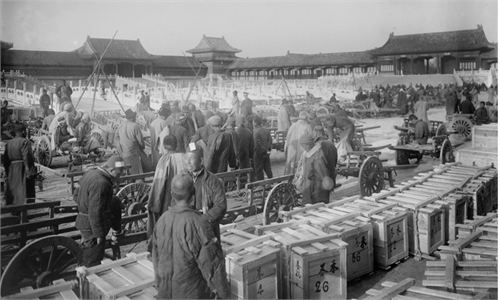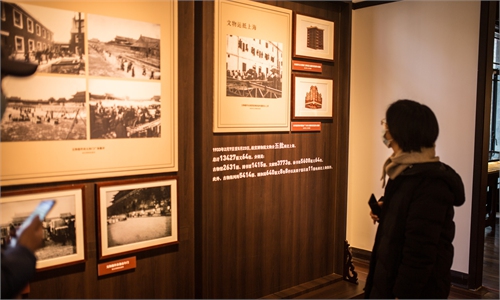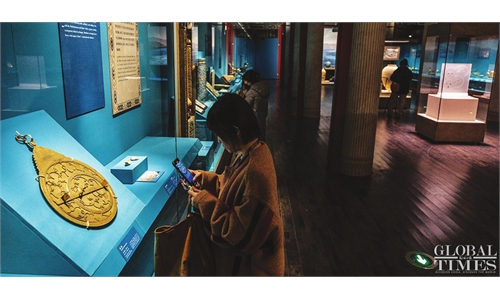IN-DEPTH / IN-DEPTH
Southward evacuation of national treasures leaves valuable experience, spiritual legacy: Beijing Palace Museum expert
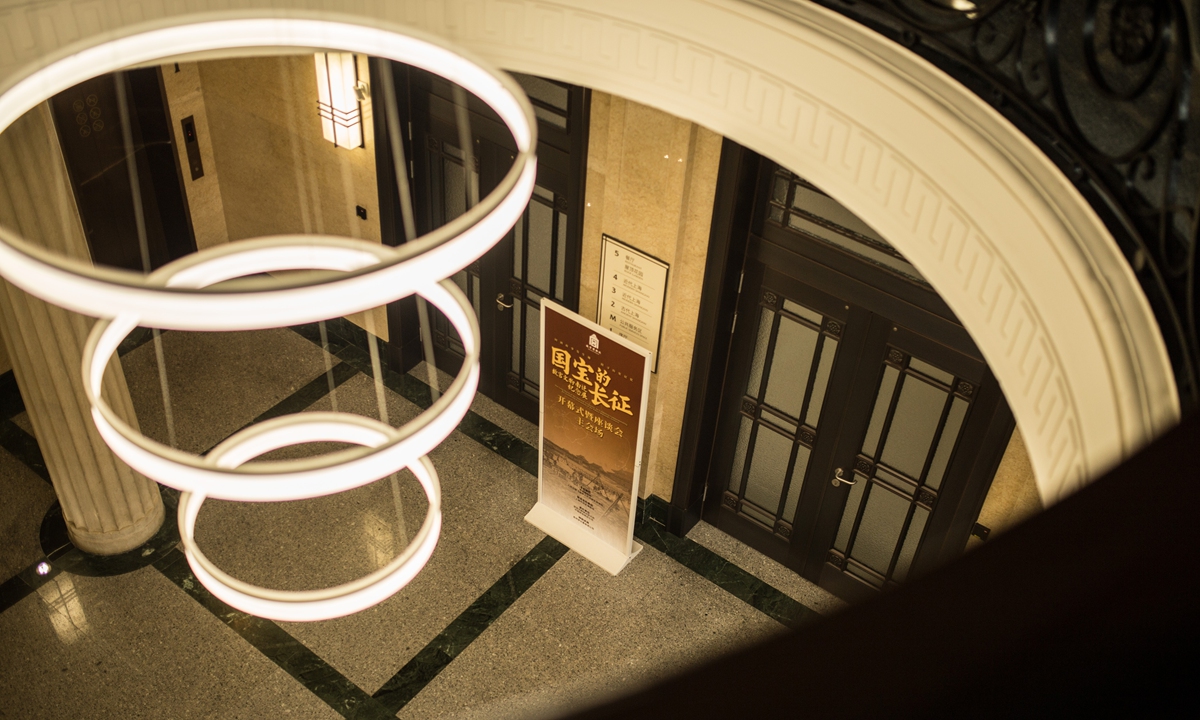
A view of "The Long March of the National Treasures: An Exhibition Commemorating the Southward Evacuation of the Palace Museum's Artifacts." Photo: Shan Jie/GT
Editor's Note:In January 1933, with the Japanese army occupying Shanhaiguan in northeastern China, the Palace Museum in Beijing decided to relocate precious cultural relics, including bronzes, porcelain, paintings, and jade, to protect them from damage and looting. Ultimately, over 19,000 boxes of "national treasures," including those from the National Museum of Art (Guwu chenliesuo in Chinese), the Summer Palace, and the Imperial College (Guozijian in Chinese) were move from Beijing to Shanghai and southwestern provinces such as Sichuan and Guizhou. Later, some of them returned to the capital city, while some are preserving in the island of Taiwan. As they stood watch over the sea, they became a testament to the shared cultural heritage of both sides of the Straits.
This 20-year journey, spanning tens of thousands of miles, was a great feat in protecting cultural heritage during the War of Resistance against Japanese Aggression (1931-1945) and created the largest-scale miracle in preserving cultural heritage during World War II. To commemorate the history and inherit the spirit, the Palace Museum and the National Humanities History magazine of the People's Daily co-hosted "The Long March of the National Treasures: An Exhibition Commemorating the Southward Evacuation of the Palace Museum's Artifacts."
Recently, Global Times reporters Shan Jie and Lin Xiaoyi (GT) interviewed Xu Wanling (Xu), the director of the Institute for Research on the Palace Museum Collection's Evacuation to the South, as she recounted this special history and its echoes and lessons for today.
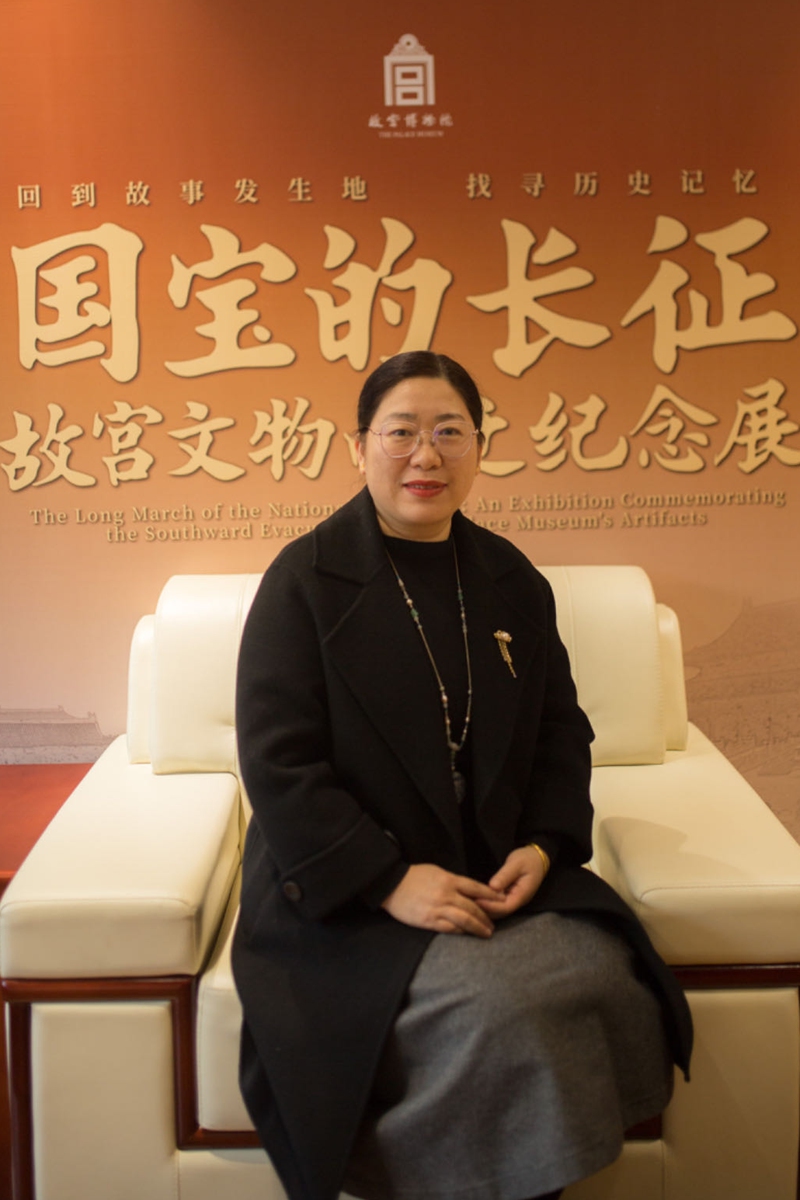
Xu Wanling, the director of the Institute for Research on the Palace Museum Collection's Evacuation to the South during the interview with the Global Times. Photo: Shan Jie/GT
GT: Could you introduce the main functions and research content of the Institute for Research on the Palace Museum Collection's Evacuation to the South? In the institute's daily work, are there any specific academic projects or research topics that you particularly value?
Xu: Established in June 2017, the Institute for Research on the Palace Museum Collection's Evacuation to the South is a non-institutional entity of the Palace Museum, initially founded to promote specialized research on the southward evacuation of cultural relics.
From 2017 to 2019, we spent over two years organizing historical materials and conducting site research on the evacuation. We gradually discovered that, in addition to the Palace Museum and the Second Historical Archives of China holding extensive materials, archives like those in Southwest China's Chongqing Municipality, Sichuan Province, and Guizhou Province also preserve valuable records from 1937 to 1947 related to the westward evacuation and eastward return of cultural relics. These archives are precisely what the Palace Museum lacks. Based on this, we have gradually established a historical and factual framework for the southern, western, and eastern evacuations, as well as relocation to the island of Taiwan and the return to Beijing.
Currently, the institute's daily work mainly involves uncovering as much historical material as possible and conducting on-site research. Another area we have been expanding in recent years is the study of southward-evacuated relics. Previously, our research on Palace Museum relics focused on interpreting craftsmanship, cultural connotations, and artistic value from a historical perspective. But now, we have shifted to discerning whether a relic is a southward-evacuated one and to which route it belongs. This approach reveals important information about the relics' wartime relocation.
The concept of southward-evacuated relics allows us to view these objects from a more holistic perspective, understanding their profound historical and cultural connotations. For example, in the early 20th century, the National Museum of Art in Beijing and the establishment of the Palace Museum compiled an inventory of about 1.4 million items, including over 230,000 artifacts from the National Museum of Art and over 1.17 million artifacts from the Palace Museum. Later, to avoid war, some relics were moved south. After undergoing southern, western, and eastern evacuations, relocation to the island of Taiwan, and the returning to the northern cities, these relics (including books and documents) are now housed in museums, libraries, and archives across the Straits. Therefore, we are putting considerable effort into this research, as it reveals more of our cultural heritage's underlying significance, which is of special meaning and value.
During our research, we also discovered some intriguing relics, like two paintings displayed in the recent exhibition - Wang Chengpei's paintings "Luck in the Whole Nation" and "Prosperity Multiplies a Hundredfold" from the Qing Dynasty (1644-1911). Originally a pair of scrolls stored at the Palace Museum's Palace of Abstinence (Zhaigong), "Luck in the Whole Nation" stayed in Beiping (Beijing) in 1933, while "Prosperity Multiplies a Hundredfold" went south and eventually to the island of Taiwan, resulting in them being housed in separate Palace Museums across the Straits.
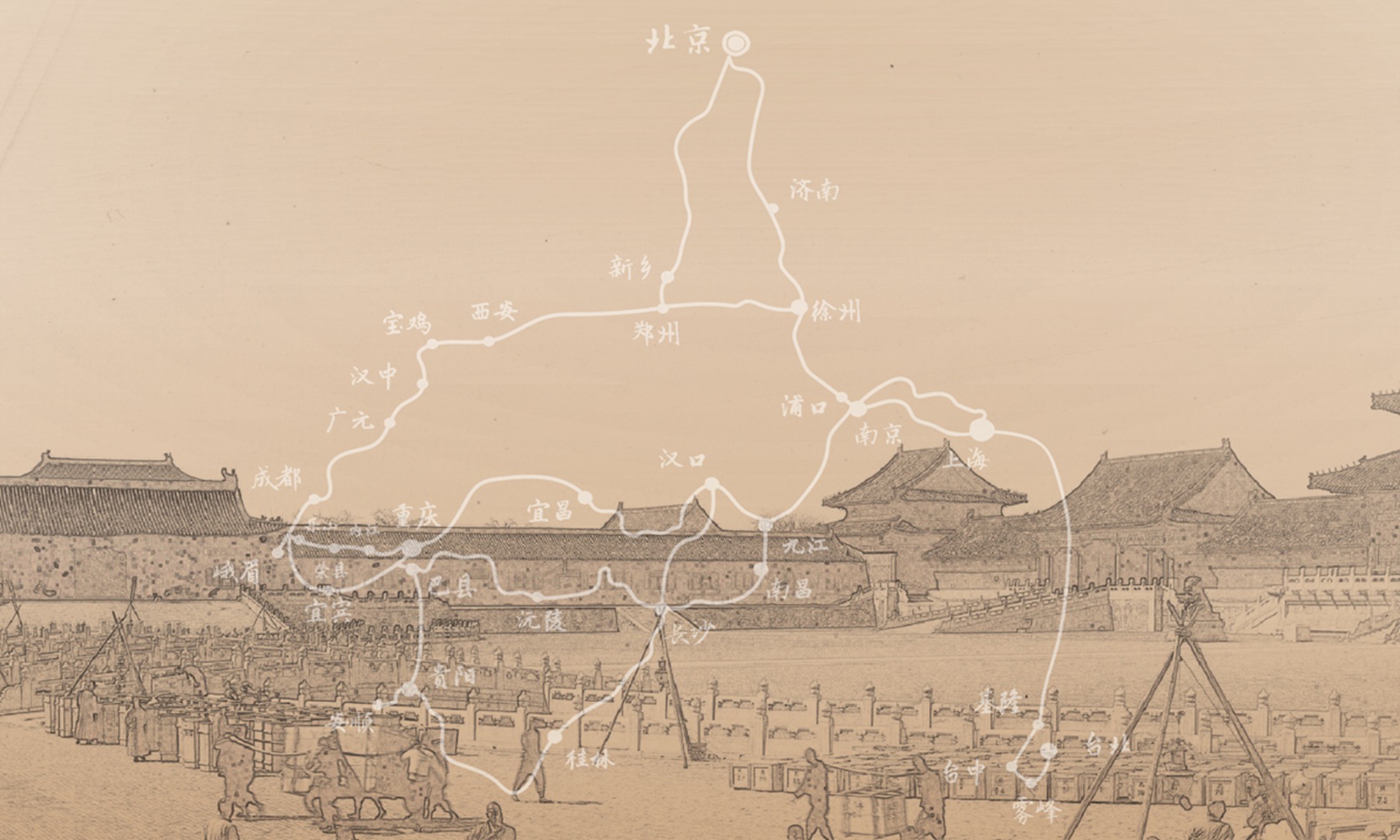
The Palace Museum cultural relics' long road to safety. Photo: Courtesy of the National Humanities History magazine
GT: In your view, why is it particularly important to commemorate the history of the Palace Museum's relics' southward evacuation?Xu: From an academic research perspective, the history of the southward evacuation of relics offers us a wealth of information. First, the large-scale evacuation of relics during wartime, lasting over 20 years and spanning tens of thousands of miles, with almost complete preservation, is remarkable. Although there were incidents like car crashes and staircase collapses, causing minor damage to some relics, these were minimal compared with the vast number of relic boxes safely preserved. As museum staff, ensuring the safety of relics is always a top priority. The Palace Museum's predecessors not only protected these precious relics but also left behind valuable preservation experience and a rich spiritual legacy.
From a cultural value standpoint, during the wartime situation, both Palace Museum staff and people from all walks of life were deeply concerned about the safety of these relics. People in the education sector in Beijing at the time made it clear: "During our national crisis, everyone is determined that no sacrifice is too great. But the cultural artifacts that embody our national pride and are tied to the nation's lifeblood and spirit must on no account be sacrificed."
These relics are closely linked to the cultural lifeline of the Chinese nation. If we lost or destroyed them, Chinese culture would suffer greatly, even to the point of interruption. Although it has been over 90 years, reading those historical documents still resonates deeply and stirs our emotions.
GT: The southward evacuation of the Palace Museum can be considered a great feat. What factors, in your opinion, ensured its success?
Xu: First, it was a large-scale, organized operation, with all external conditions supporting the action. For instance, coordinating the special transportation of relics required professional arrangements, including dedicated train convoys, accompanying guards, and military personnel for protection.
Secondly, there was a need for dedicated storage space, initially renting sturdy foreign-owned warehouses or building reinforced concrete storerooms, later requisitioning bank vaults or even local temples and ancestral halls.
Additionally, many specific tasks had to be implemented, like supplying daily necessities such as food for Palace Museum staff who relocated. Therefore, the residents of Leshan and Emei in Sichuan Province allocated land and distributed food to them. These comprehensive arrangements and implementations could not have been achieved without the understanding and support of local governments, various departments, and the general public.
GT: What insights and impacts does the story of the relics' southward evacuation have on contemporary global practices in cultural heritage protection?
Xu: Due to my research on the Palace Museum's wartime relic preservation, I pay close attention to cases of cultural heritage protection during wartime worldwide. In 2017, the Palace Museum held an exhibition titled "Reborn from the Flames - Afghanistan: Treasures from the National Museum, Kabul." I was deeply moved by this exhibition, both amazed by Afghanistan's splendid civilization and saddened by its years of war.
In 2018, during my research visit to the UK, I particularly noticed how British museums protected their relics during wartime. Before the London Blitz, important collections from the National Gallery were evacuated to universities, libraries, and castles in Wales.
When war breaks out, its destructive power is unimaginable. Yet, in the face of such uncontrollable destruction, people still try their best to protect what they consider to be important artistic and cultural items. In fact, this is true worldwide. So, when we see such images, we are deeply impacted.
For our generation, studying the protection of cultural heritage during wartime often involves reconstructing understanding and imagination through historical images and documentary expressions. The reality and brutality of war are undoubtedly far beyond our imagination. Therefore, we should study this history, understand the devastation of war, and appreciate the value of peace.
Before preparing the exhibition, we visited the Commercial Press's history display in Beijing. I was touched by their history, which stated: "Sacrificed for national adversity and struggled for culture." The Commercial Press was bombed during the war, and its Oriental Library and ancient books were reduced to ashes in an instant. Yet, facing the bombing, it was quickly rebuilt. The ideals and courage of the intellectuals at the time, along with their guardianship of national culture, are spirits that transcend time.
Therefore, I believe studying the topic of the southward evacuation of relics, whether through exchange and cooperation, exhibition dissemination, or academic discussion, is to tell everyone the historical fact: During the entire War of Resistance against Japanese Aggression, China's cultural relics suffered heavy losses, but the Palace Museum's relics suffered minimally. This contrast between heavy loss and minimal damage is a fortunate outcome amid misfortune.
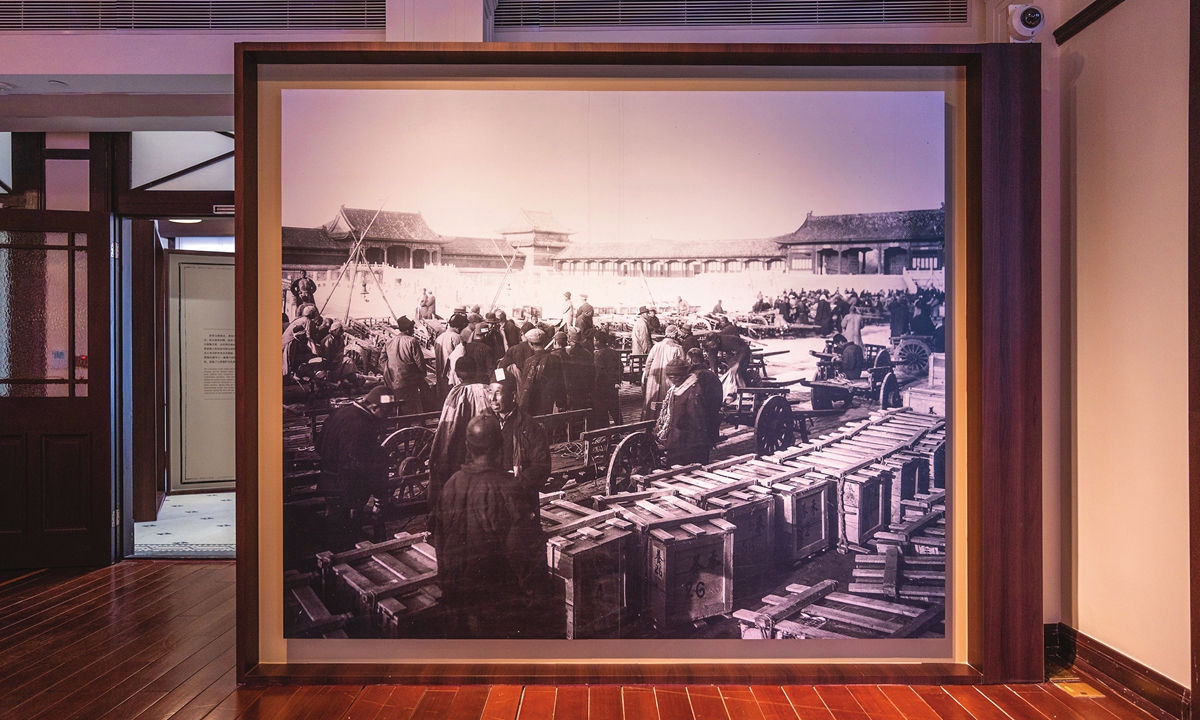
The photo that captures the relocation of the Palace Museum's artifacts during the southward evacuation.Photo: Courtesy of the National Humanities History magazine
GT: What contributions does the commemorative touring exhibition of the southward evacuation of the Palace Museum's relics make to enhance the international community's understanding of China's cultural heritage?Xu: Through research on the southward evacuation of relics and the relics themselves, we strengthen connections and cooperation with numerous domestic museums, archives, and libraries, continuously refining the historical context of the relics' evacuation and gradually expanding their cultural influence. At the same time, we actively promote exchanges and cooperation with foreign museums, sharing experiences and achievements in the protection of cultural relics during wartime.
Through these academic exchange activities, we aim to show the world the responsibilities and missions of museums, to protect the common cultural heritage of humanity, and to promote exchanges and mutual learning among different countries, ethnicities, and cultures. We hope these research and exchange activities provide new perspectives and pathways for global cultural heritage protection, creating new resonances and understanding.

